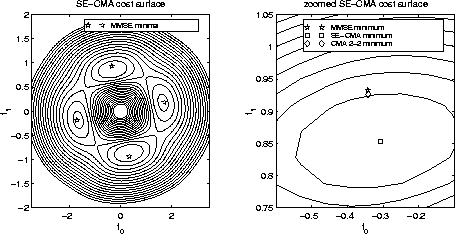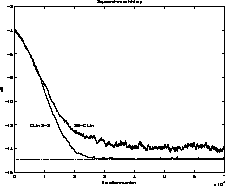


Next: More on the simulations.
Up: Simulation Results
Previous: 32-tap equalizer with 64-tap
Now consider the same communications system, but with symbols
chosen from a unit-variance 8-PAM alphabet, the channel given by
![$\ensuremath{\mathbf{c}}=\left[\begin{array}
{cccc}0.2&0.5&1&-0.1\end{array}\right]^T$](img34.gif) ,
and a two-tap FSE (Nf=2).
,
and a two-tap FSE (Nf=2).
Figure 8:
SE-CMA cost contours with 8-PAM source, 15 dB SNR
 |
Figure 8 shows the SE-CMA cost contours
for this system when the SNR is 15 dB. However,
the SE-CMA minimum is now further from the MMSE minimum than is CMA 2-2.
For 70,000 iterations with
 , a portion of the squared-error history for a simulation
is shown in Figure 9.
, a portion of the squared-error history for a simulation
is shown in Figure 9.
Figure 9:
Comparison of error history for SE-CMA and CMA 2-2 with 8-PAM source
 |
As shown, CMA 2-2 now attains a lower error than SE-CMA. Therefore, it has been shown
that SE-CMA is inferior for anything more complicated than BPSK sources. I tried various
simulations with other more complicated alphabets such as
4-PAM, 16-PAM, etc., and found that CMA 2-2 performs better in
these cases as well.



Next: More on the simulations.
Up: Simulation Results
Previous: 32-tap equalizer with 64-tap
Andrew Grant Klein
8/12/1998
![]() ,
and a two-tap FSE (Nf=2).
,
and a two-tap FSE (Nf=2).
![]() , a portion of the squared-error history for a simulation
is shown in Figure 9.
, a portion of the squared-error history for a simulation
is shown in Figure 9.